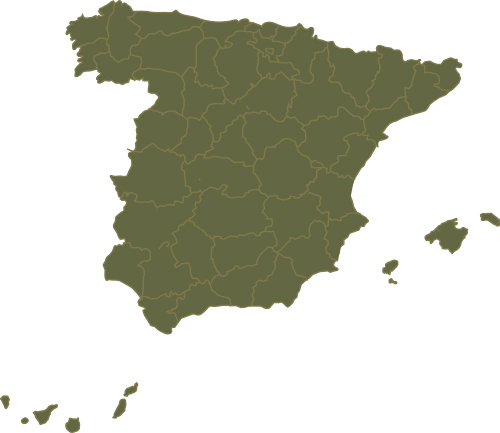The abundance of native grape varieties fostered an early start to viticulture with evidence of grape pips dating back to the Tertiary period. Archaeologists believe that these grapes were first cultivated sometime between 4000 and 3000 BC, long before the wine-growing culture of the Phoenicians founded the trading post of Cádiz around 1100 BC.
Spanish wines (vinos españoles) are wines produced in Spain. Located on the Iberian Peninsula, Spain has over 1.2 million hectares (2.9 million acres) planted, making it the most widely planted wine-producing nation but it is the third largest producer of wine in the world, the largest being Italy and France, followed by the United States. This is due, in part, to the very low yields and wide spacing of the old vines planted on the dry, infertile soil found in some of the Spanish wine regions. The country is ninth in worldwide consumption with Spaniards drinking, on average, 21.6 litres (5.7 US gal) per person a year. The country has an abundance of native grape varieties, with over 400 varieties planted throughout Spain though 88 percent of the country’s wine production is from only 20 grapes — including the reds Tempranillo, Bobal, Garnacha, and Monastrell; the whites Albariño, Airén, Verdejo, Palomino, and Macabeo; and the three Cava grapes Parellada, Xarel·lo, and Macabeo.
Major Spanish wine regions include the Rioja and Ribera del Duero, which are known for their Tempranillo production; Jumilla, known for its Monastrell production; Jerez de la Frontera, the home of the fortified wine Sherry; Rías Baixas in the northwest region of Galicia that is known for its white wines made from Albariño and Catalonia which includes the Cava and still wine producing regions of the Penedès as well the Priorat region.

The abundance of native grape varieties fostered an early start to viticulture with evidence of grape pips dating back to the Tertiary period. Archaeologists believe that these grapes were first cultivated sometime between 4000 and 3000 BC, long before the wine-growing culture of the Phoenicians founded the trading post of Cádiz around 1100 BC.
Spanish wines (vinos españoles) are wines produced in Spain. Located on the Iberian Peninsula, Spain has over 1.2 million hectares (2.9 million acres) planted, making it the most widely planted wine-producing nation but it is the third largest producer of wine in the world, the largest being Italy and France, followed by the United States. This is due, in part, to the very low yields and wide spacing of the old vines planted on the dry, infertile soil found in some of the Spanish wine regions. The country is ninth in worldwide consumption with Spaniards drinking, on average, 21.6 litres (5.7 US gal) per person a year. The country has an abundance of native grape varieties, with over 400 varieties planted throughout Spain though 88 percent of the country’s wine production is from only 20 grapes — including the reds Tempranillo, Bobal, Garnacha, and Monastrell; the whites Albariño, Airén, Verdejo, Palomino, and Macabeo; and the three Cava grapes Parellada, Xarel·lo, and Macabeo.
Major Spanish wine regions include the Rioja and Ribera del Duero, which are known for their Tempranillo production; Jumilla, known for its Monastrell production; Jerez de la Frontera, the home of the fortified wine Sherry; Rías Baixas in the northwest region of Galicia that is known for its white wines made from Albariño and Catalonia which includes the Cava and still wine producing regions of the Penedès as well the Priorat region.
Tradesa Corp.
618A Fleet St., Toronto, Ontario, Canada
M5V 1B9
Phone
416.944.WINE (9463) / 416.924.VINO (8466)
Fax: 416 928 0908
